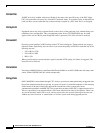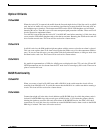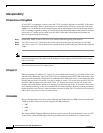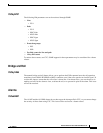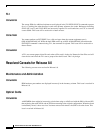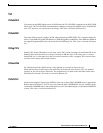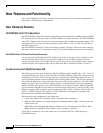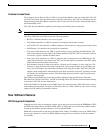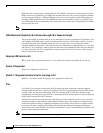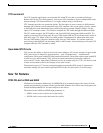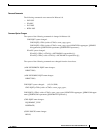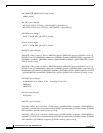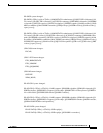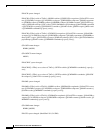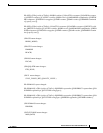
12
Release Notes for Cisco ONS 15600 Release 8.0
OL-10906-01
New Features and Functionality
Different cards are tested with a limited subset of Cisco PPMs. Customers are encouraged to use these
PPMs, referred to as Qualified Cisco PPMs (for the particular card). Since each card supports different
services (rates and formats), a PPM qualified for one card is not necessarily qualified for another. For
example, a PPM qualified to work on a DWDM card may not be qualified to work on a SONET card.
Cisco PPMs that are not recommended for use with a particular card are termed Unqualified Cisco PPMs
(for the particular card).
Note This feature may not be described in the Release 8.0 documentation
DISA Password Complexity, Max Password Length, Min Password Length.
The password length, by default, must be set to a minimum of six and a maximum of 20 characters. You
can configure the default values in node view through Provisioning > NE Defaults > Node > security >
passwordComplexity. The minimum length can be set to eight, ten or twelve characters, and the
maximum length to 80 characters. The password must be a combination of alphanumeric (a-z, A-Z, 0-9)
and special (+, #,%) characters, whereat least two characters are nonalphabetic and at leastone character
is a special character. For TL1 compatibility, the password must be 6 to 10 characters. The password
must not contain the user name.
Required JRE Version is 5.0
JRE version 5.0 was optional in Release 7.0. It is required for release 8.0 that JRE be version 5.0.
Solaris 10 Supported.
Solaris 10 is supported in release 8.0
Mozilla 1.7 Supported on Solaris 9 with Java plug-in 5.0.
Mozilla 1.7 on Solaris 9 with Java plug-in 5.0 is supported in release 8.0.
IPv6
Cisco ONS 15xxx products can function in an IPv6 network when an internet router that supports
Network Address Translation - Protocol Translation (NAT-PT) is positioned between the GNE, such as
an ONS 15454, and the client workstation. NAT-PT is defined in RFC-2766. IPv4 and IPv6 nodes
communicate with each other using NAT-PT by allowing both IPv6 and IPv4 stacks to interface between
the IPv6 DCN and the IPv4 DCC networks.
NAT-PT binds addresses in IPv6 networks with addresses in IPv4 networks and vice versa to provide
transparent routing for the packets traveling between address types. This requires no changes to end
nodes and IP packet routing is completely transparent to end nodes. It does, however, require NAT-PT
to track the sessions it supports and mandates that inbound and outbound datagrams pertaining to a
session traverse the same NAT-PT router. Protocol translation is used to extend address translation with
protocol syntax/semantics translation.
Note Only Mozilla 1.7 is supported on clients interfacing with IPv6 networks.



